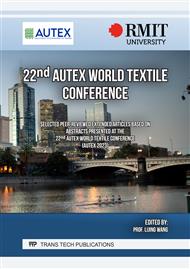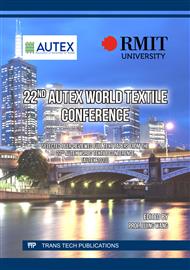p.3
p.15
p.23
p.33
p.39
p.49
p.61
p.67
Influence of Laccase Enzyme on the Biodegradability of Indigo Blue Dyed 100% Cotton Fabrics
Abstract:
Abstract: Improving the environmental impact of textile waste is essential for the good functioning of the planet, as it is not viable to prolong the recycling of textile materials indefinitely due to the loss of properties. The presence of dyes in fabrics is a key point to study from the perspective of biodegradability, as the presence of these dyes in effluents is widely studied due to their high polluting impact on water. This project has analysed whether the presence of dyes in fabrics affects their biodegradability process. In addition, it has been studied whether finishing with laccase enzyme, which is usually used to purify the wastewater from the dyes of the indigo blue dye used, influences the degradation of the fabric. For this purpose, dyed and undyed cotton fabrics impregnated with this enzyme were analysed. Following the proposed measurement protocol, it has been defined that fabrics dyed with the indigo blue dye (VAT BLUE I) have a positive influence on degradation, while the presence of small doses of compounds added to the fibres, such as the laccase enzyme studied in this case, can lead to the generation of deviations in the biodegradability of the sample. Although the efficiency and efficacy of this enzyme in dye degradation under anaerobic conditions has been demonstrated, under compost conditions its effectiveness decreases and negatively influences the biodegradability process. No ecotoxicity is shown in soil after the biodegradation process. Keywords: Sustainability; laccase; vat dye; textile; environment; burial.
Info:
Periodical:
Pages:
23-31
Citation:
Online since:
March 2024
Keywords:
Price:
Сopyright:
© 2024 Trans Tech Publications Ltd. All Rights Reserved
Share:
Citation:



